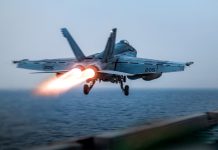Indonesia may be poised to acquire three cutting-edge weapons systems from China, including a multi-role fighter aircraft (J-10), a missile boat, and an anti-ship missile.
The development comes as Jakarta, under President Prabowo Subianto, has kicked off an aggressive push to modernize its military to combat challenges. “The world is full of uncertainty, and even if we dislike war, wars are happening everywhere,” Mr Prabowo said alongside senior commanders and political allies.
Indonesia has been steadily diversifying its arms purchases to avoid over-reliance on a single supplier. It states that the pragmatic, non-aligned defense strategy reflected in Indonesia’s procurement plan provides the country with considerable flexibility to seek military agreements with a variety of partners.
In line with that strategy, Indonesia’s Defense Minister, Sjafrie Sjamsoeddin, recently announced that the country could acquire J-10 fighter jets from China. ”They will be flying over Jakarta soon,” Sjamsoeddin stated, without disclosing more specific details.
The disclosure came months after the Indonesian Deputy Defense Minister Donny Ermawan Taufanto announced that China had offered the J-10C jets to the country.
The Minister said the government was examining whether the aircraft, widely used by the Chinese People’s Liberation Army Air Force (PLAAF), could meet operational requirements and be integrated with existing Indonesian platforms.
“This is just an offer,” Taufanto had said at the time, indicating that the discussions were in a very nascent stage. “We have had talks with China and they offered us a lot, not just J-10, but also ships, arms, frigates.”
The recent decision suggests that the talks and assessment have progressed faster than previously anticipated and include more than just the J-10 fighter jets.
Indonesia’s Arms Purchases From China
The Indonesian Ministry of Finance (MoF) approved plans for the country to use foreign loans to finance the purchase of three defense systems from China, according to a report by Janes.
As per the documents, including a letter from Indonesia’s Ministry of Finance (MoF) to its Ministry of Defense (MoD) that were provided to Janes, a total loan amount of USD 3.1 billion has been approved, particularly for the purchase of J-10B multi-role aircraft, the Houbei fast attack craft, and the CM-302 coastal anti-ship missile.
In fact, the report states that Indonesia has already started looking for lenders to back the proposal.
Indonesia’s Future Purchase Of J-10
The MoD has been authorized to source up to USD 1.6 billion in foreign loans to fund the purchase of the J-10B fighter aircraft, according to Janes. These loans could come from commercial lending institutions, bilateral creditors, or foreign export credit agencies.
It is pertinent to note that the Janes report states that Indonesia intends to use the program to acquire used J-10B airframes that were previously used by China’s People’s Liberation Army Air Force (PLAAF).
This is in contrast to media reports claiming that Jakarta wants to acquire 42 J-10C fighters, the latest and most advanced variant of the aircraft, which has only been sold to Pakistan.
The EurAsian Times has contacted the Indonesian Ministry of Defense and awaits a formal confirmation.
Chengdu J-10B
The Chengdu J-10B is an advanced multi-role fighter aircraft developed by China’s Chengdu Aircraft Industry Corporation (CAC) as an upgraded variant of the baseline J-10A “Vigorous Dragon”, the first major indigenously produced aircraft.
The J-10B retains the J-10 family’s single-engine, single-seat layout with a canard-delta wing for high agility.
The J-10B was initially powered by the Russian Saturn-Lyuika AL-3FN Series 3 engine, which provided more thrust than the older models. However, it was later swapped for the locally-made WS-10B engines.
The J-10B qualifies as a thrust-vectoring variant with super maneuverability, which gives it a decisive advantage in a dogfight.
The J-10B features a new fixed diverterless supersonic inlet (DSI), a concept also found on the F-35 Lightning II, a wide-angle holographic head-up display (HUD), a helmet-mounted display, three big-color multi-functional displays (MFDs), an infrared search and track (IRST), and a laser rangefinder ball in front of the canopy.
Additionally, it is equipped with a passive electronically scanned array (PESA) radar system operating in the X band, and carries PL-10 and PL-12 missiles.
The J-10B itself has seen no major new developments in the last decade, as focus shifted to the J-10C. In fact, some reports suggest that all J-10s built after 2015 are in the C variant, which has now been tested in combat by Pakistan.
The J-10C surpasses the J-10B, rivaling the Rafale or Eurofighter in BVR due to AESA radar and PL-15 missiles, but the J-10B is in itself a very capable multi-role fighter.

Indonesia might be able to get these fighters at a much lower cost than a brand-new J-10C. The ambitious country is already buying Rafale, has signed up for the Turkish KAAN fighter, and is co-developing the KF-21 in collaboration with South Korea.
Notably, the reports of J-10’s purchase have stirred quite a storm, with analysts claiming that it could create a rift between Jakarta and Washington, especially as the latter has offered the F-15EX to the Indonesian Air Force.
However, Major General Freddy Ardianzah, head of the Indonesian National Armed Forces (TNI) Information Center, said that the procurement will not affect its military relations with other countries, including the US.
Meanwhile, Brigadier General Frega Wenas Inkiriwang, head of the Ministry of Defense’s information bureau, told the media that the Indonesian Air Force is still evaluating the suitability of the J-10 for the service.
“The J-10s are under review by the Air Force. We want only the best platforms for our defense needs,” he said. If true, this could mean that the purchase is not set in stone, after all.
The Houbei (Type 22) Fast Attack Craft
The Type 22 is a class of fast, agile, stealthy, and powerful missile boats operated by the Chinese People’s Liberation Army (PLA) Navy.
The missile boat was designed to operate in China’s littoral zone and conduct coastal patrols. It has a capacity for 12 crew members and is equipped with eight anti-ship missiles, making it a formidable threat.
Built over a catamaran design, the Type 22 Houbei Class stealth missile boats provide the Chinese PLA Navy with a low observable missile launch platform against enemy vessels, along with air defense capability.
The Type 22 missile boat is just over 200 tons, but provides high mobility, high stealth capability, and strong firepower. These boats carry the YJ-83 subsonic anti-ship cruise missiles and a licensed copy of the AK-603 6-barrel 30mm Gatling gun.
Chinese military affairs specialist Wang Yunfei earlier told a state-owned publication, Global Times, that the Type 22 missile boat was created and constructed about 20 years ago, when the PLA Navy had few major ships but was tasked with significant coastal defense responsibilities. It performed the role well, as it could sail at roughly 50 knots and carry anti-ship missiles on marine attack missions.
Nonetheless, it can still play a meaningful role even though the PLAN has transitioned from purely coastal defense to a combination of coastal and far seas defense after commissioning large warships like aircraft carriers and amphibious assault ships.
Wang noted that the Type 22 can easily outperform warships of similar sizes from other nations. “The water is shallow near islands and reefs in the South China Sea, and boats like the Type 22 can move flexibly when larger vessels would need to worry about hitting the rocks,” he asserted.
In October 2024, the ship chased a Philippine vessel conducting maritime patrols in the West Philippine Sea, near First Thomas Shoal or Bulig Shoal, as reported by the EurAsian Times. It also targeted a BFAR jet with lasers three times while it was performing patrols–a first for its profile.
The potential acquisition of the Type 022 would provide Indonesia with a relatively low‑cost platform capable of delivering anti‑ship missiles against larger adversary surface ships.
It would be useful in denying access to choke points and straits. Notably, Indonesia’s geography favors many small, fast vessels that can operate from dispersed bases, which is exactly the environment these boats are designed for.
When linked to shore radars, maritime patrol aircraft, helicopters, and modern C4ISR, these boats can also be cued to high‑value targets beyond their own sensors, greatly increasing effectiveness. Thus, it fits right into the networked modern combat requirements.
CM-302 Missile For Coastal Defense
Jakarta intends to acquire land-based versions of the CM-302 weapon for coastal defense, and the MoD has been authorized to secure up to USD 1 billion in foreign loans for the purchase of the missile, as per Janes.
Funding could potentially come from private lending organizations, bilateral creditors, or international export credit agencies.
The CM‑302 is an export variant of China’s YJ-12 ramjet-powered coastal anti-ship missile. It is widely described as a supersonic, sea‑skimming, anti‑ship cruise missile intended to strike surface warships with high speed and a heavy warhead.
It is considered to be an analog of the Indo-Russian BrahMos missile. Interestingly, Indonesia is also looking to acquire the supersonic BrahMos missiles from India.
The YJ-12 missile had earlier been deployed to mainland China’s shoreline and artificial islands in the South China Sea, posing a direct threat to Taiwan and American aircraft carrier strike groups.
These missiles are effective for anti‑access/area denial in confined seas, straits, archipelagos, and can be deployed as dispersed coastal batteries or on small ships to threaten larger warships. They are cheaper than large cruise missiles and could be used in salvos to overwhelm hostile air defense systems in combat.

Lyu Xiaoge, spokesman for China Aerospace Science and Industry Corp, told China Daily in 2016 that CM-302 is the best anti-ship missile available on the world’s arms market and “it’s not an exaggeration.”
Lyu emphasised that the missile can fly at supersonic speeds during its entire 290-kilometer trajectory, and it could be mounted on ships, aircraft, or ground vehicles. It could be used to target land-based targets.
According to Lyu, the CM-302, in addition to its speed and adaptability, has more destructive power and a better capacity to breach fortifications than other missiles of its class available on the market.
A CM-302 can disable a guided missile destroyer weighing 5,000 metric tons, he stated. It carries a 250-kilogram warhead and is an effective weapon against large warships, including aircraft carriers and destroyers. CM-302 is characterized by its small size, light weight, strong power, modular design, and high accuracy.
Thus, it would be a valuable addition to the Indonesian Navy, which is currently undergoing modernisation to combat contemporary regional threats.
- Contact the author at sakshi.tiwari13 (at) outlook.com
- Follow EurAsian Times on Google News




